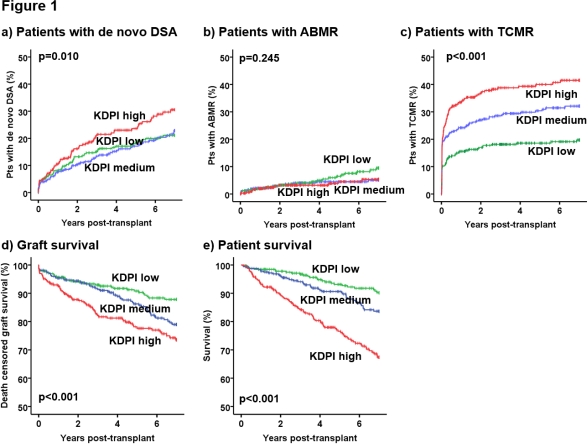Acute Rejections and Incidence of De Novo DSA Depend on Donor Factors and Deceased Donor Kidney Associated Risk Assessed by the Kidney Donor Profile Index (KDPI).
Nephrology, Charite, Berlin, Germany.
Meeting: 2016 American Transplant Congress
Abstract number: B183
Keywords: Allocation, Graft function, Kidney transplantation, Rejection
Session Information
Session Name: Poster Session B: Kidney Transplantation: KDPI, HCV/Matching, Donor Age
Session Type: Poster Session
Date: Sunday, June 12, 2016
Session Time: 6:00pm-7:00pm
 Presentation Time: 6:00pm-7:00pm
Presentation Time: 6:00pm-7:00pm
Location: Halls C&D
Introduction: Little data exist analyzing the influence of donor kidney quality on the immunologic outcome and applying the KDPI in a European cohort.
Methods: This retrospective long-term observational study included 987 deceased donor kidney recipients (KTR) transplanted 1991-2014. KDPI was determined using the OPTN mapping table 2014 as reference. Data analysis included patient and graft survival, biopsy proven T cell mediated (TCMR) and antibody mediated rejections (ABMR) and development of de novo donor specific antibodies (DSA). Outcome data were assessed over maximal 23 years.
Results: The mean recipient age was 52 years, median donor KDPI was 66%. Two- and five-year graft survival rates were 92% and 85%. Recipients were further classified according to the KDPI tercile (resulting in groups with a KDPI range 0-49%, 49-83% and 83-100%). KTR receiving higher KDPI kidneys were older, had more HLA mismatches and showed shorter cold ischemia time. They developed significantly more de novo DSA, TCMR, graft failures and had a poorer survival (Fig. 1 a-e). Estimation of predictors for TCMR revealed a significant association with HLA mismatches, donor age, donor hypertension (HR 1.66), donor cerebrovascular death (HR 1.33) and donor KDPI. A multivariate analysis adjusted for all relevant variables identified HLA-mismatches (HR 1.24 per mismatch, p<0.001), cold ischemia time (HR 1.26 per 10 hours, p=0.027), and donor KDPI (HR 1.20 per 10%, p=0.002) as independent risk factors for TCMR. Higher recipient age was an independent protective factor (HR 0.90, p=0.037).
Discussion: Patients in this study cohort allocated within Eurotransplant received mostly kidneys procured from donors with significantly higher KDPI in comparison with the US reference cohort, nevertheless resulting in good graft survival rates. Donor factors leading to kidney injury play an important role toward acute rejection and developing of de novo DSA. A high donor KDPI is an independent risk factor for TCMR.

CITATION INFORMATION: Staeck O, Khadzhynov D, Lehner L, Kleinsteuber A, Duerr M, Schrezenmeier E, Budde K, Halleck F. Acute Rejections and Incidence of De Novo DSA Depend on Donor Factors and Deceased Donor Kidney Associated Risk Assessed by the Kidney Donor Profile Index (KDPI). Am J Transplant. 2016;16 (suppl 3).
To cite this abstract in AMA style:
Staeck O, Khadzhynov D, Lehner L, Kleinsteuber A, Duerr M, Schrezenmeier E, Budde K, Halleck F. Acute Rejections and Incidence of De Novo DSA Depend on Donor Factors and Deceased Donor Kidney Associated Risk Assessed by the Kidney Donor Profile Index (KDPI). [abstract]. Am J Transplant. 2016; 16 (suppl 3). https://atcmeetingabstracts.com/abstract/acute-rejections-and-incidence-of-de-novo-dsa-depend-on-donor-factors-and-deceased-donor-kidney-associated-risk-assessed-by-the-kidney-donor-profile-index-kdpi/. Accessed December 24, 2025.« Back to 2016 American Transplant Congress
